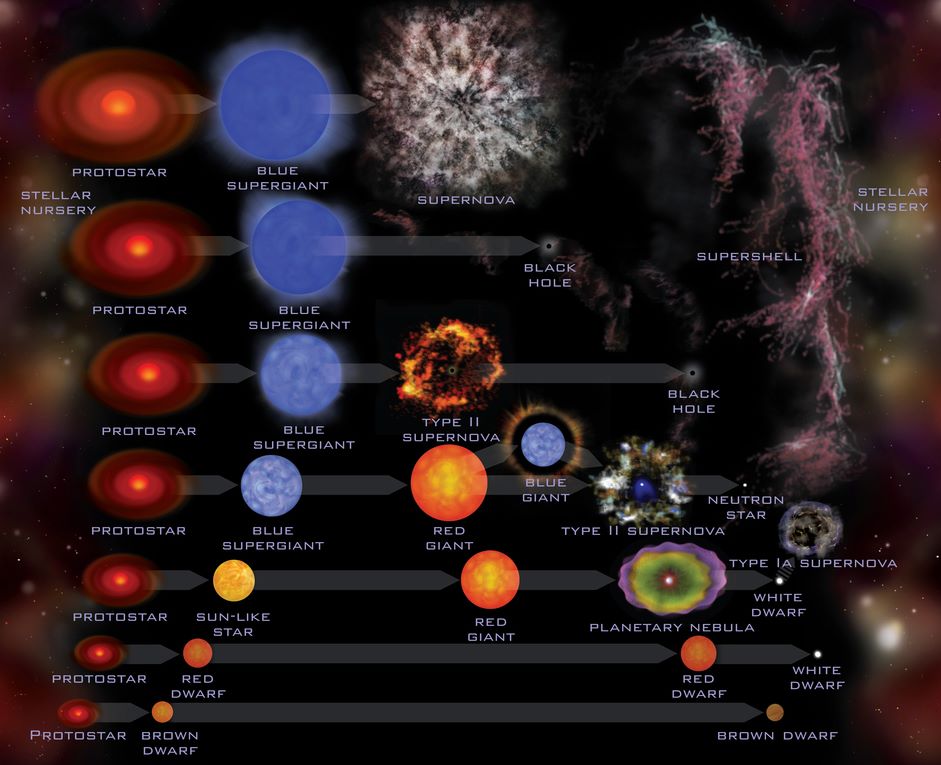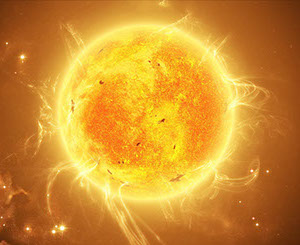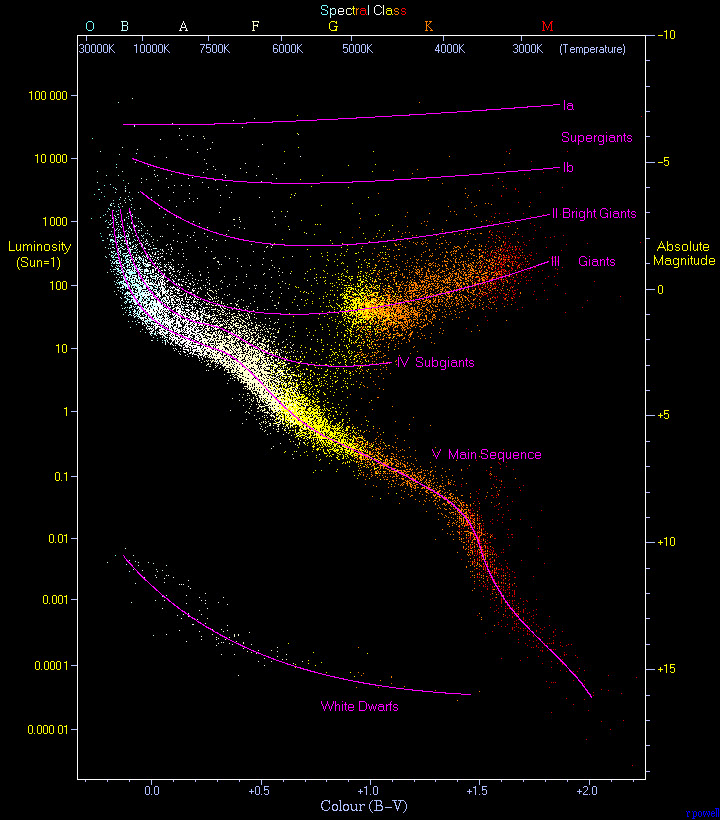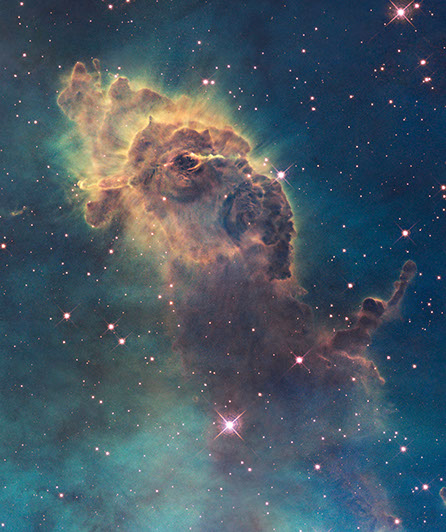Stars
Definition - Stars are giant balls of gases composed of hydrogen and helium which are held together by their own gravity and pressure through generation of energy in nuclear reactions
Information
Star Size Comparison
A size comparison chart displaying the size relationship with different types of stars
Red Hyper Giant
Our Sun
Yellow Hyper Giant
Red Super Giant
Blue Hyper Giant
Blue Super Giant
Blue Giant
Red Giant
(Our sun once it stars dying)
Blue Dwarf
Yellow Dwarf
(Our sun)
Red Dwarf
Brown Dwarf
White Dwarf
Neutron
Black Dwarf
Kelvin (K)
C = K - 273
F = (9)
Solar Masses (M)
1 M = 1.98855 x 10 kg
30
Solar Radii (R)
1 R = 6.955 x 10 km
1 R = 432,450 miles
5
Luminosity (L)
1 W = 3.846 x 10 km
26
Proportion of Stars in our Solar System
Blue
0.00003%
Blue White
0.13%
White
0.6%
Yellow White
3.0%
Yellow
7.6%
Orange
12.1%
Red
76.45%
Gravitational Attraction of Stars
How are stars born?

Death of a Star


What is a star?
A star is a ball of gases of mainly hydrogen and helium held together by its own gravity. The force of its gravity would collapse the star if it wasn’t counteracted by the pressure of hot gas and radiation from the star’s interior. This counteraction is called hydrostatic support. The star creates its own energy through nuclear fusion; the collision two or more atomic nuclei which creates new types atomic nuclei with some matter converted to photons.
Properties of a star
Distance: The only direct way to measure stellar distances is through parallaxes - the change in direction toward a nearby star due to our change in position as the earth goes around its orbit.
Luminosity: the luminosity is a direct measure of the rate at which nuclear fusion is proceeding in the star's core.
Radius: This can be found by using the luminosity formula. A combination of radius and mass of a star determines the surface gravity
Composition: Stars are comprised of about 90% hydrogen, 10% helium, and traces of heavy elements. The heavy elements will vary depending on the type of star.
Mass: Kepler's Law can be used to determine the masses of the stars by plotting the orbit and measuring the orbital period. A combination of radius and mass of a star determines the surface gravity
Star Temperatures
Temperature (K)
Color Description
Apparent Color
Mass (solar masses)
Radius (solar radii)
Luminosity
Class
≥ 30,000 K
Blue
≥ 16 M
≥ 6.6 R
≥ 30, 000 L
Blue
O
10,000 - 30,000 K
Deep Blue White
2.1 - 16 M
1.8 - 6.6 R
25 - 30,000 L
Blue White
B
7,500 - 10,000 K
Blue White
1.4 - 2.1 M
1.4 - 1.8 R
5 - 25 L
White
A
6,000 - 7,500 K
White
1.04 - 1.4 M
1.15 - 1.4 R
1.5 - 5 L
Yellow White
F
5,200 - 6,000 K
Yellowish White
0.8 - 1.04 M
0.96 - 1.15 R
0.6 - 1.5 L
Yellow
G
3,700 - 5,200 K
Pale Yellow Orange
0.45 - 0.8 M
0.7 - 0.96 R
0.08 - 0.6 L
Orange
K
2,400 - 3,700 K
Light Orange Red
0.08 - 0.45 M
≤ 0.7 R
≤ 0.08 L
Red
M
1,300 - 2,400 K
Scarlet
0.005 - 0.08 M
≤ 0.7 R
≤ 0.08 L
Red Brown
L
500 - 1,300 K
Magenta
0.001 - 0.05 M
≤ 0.7 R
≤ 0.08 L
Brown
T
≤ 500 K
Black
≤ .001 M
≤ 0.7 R
≤ 0.08 L
Dark Brown
Y
Stars are often born in a cloud of dust and gases called a Steller Nebula. As the gas cloud collapses, a dense, hot core forms and begins gathering dust and gas. Not all of this material ends up as part of a star some of the dust can become planets, asteroids, or comets or may remain as dust. As more and more atoms gather together the gravitational force increases pulling more and more atoms into the cluster. As more atoms join the cluster the atoms at the center are squeezed under such high pressure resulting in fusion reactions.
If a specific temperature is not reached the fusion reactions will not occur and the star will end up as a brown dwarf star. If the fusion temperature is met, the hydrogen will begin fusing into helium, this will be the beginning of a stars life cycle which is known as a Protostar.
Life Cycle of a Star
The lifetime of a star depends on its mass. High-mass stars evolve faster and die sooner than low-mass stars. The most massive stars may live only a few million years, and the low-mass stars can live 100's of billions of years. Low-mass stars live long because they burn helium at a much lower rate then massive stars.
Low-mass stars die quietly, while high-mass stars die in tremendous explosions known as a supernova explosion.
Stars Fusion Process
Once the star stars the fusion of hydrogen into helium it continues this process for millions to billions of years.
Process
- Nuclear fusion
- Hydrogen atoms at center deplete
- Fusion reactions stop briefly
- Due to the gravitational force, more hydrogen atoms are pulled to the center
- As more atoms are pulled toward the center, the temperature increases and the fusion reactions start again
Life Time of a Star
Once the star stars the fusion of hydrogen into helium it continues this process for millions to billions of years.
Process
- Nuclear fusion
- Hydrogen atoms at center deplete
- Fusion reactions stop briefly
- Due to the gravitational force, more hydrogen atoms are pulled to the center
- As more atoms are pulled toward the center, the temperature increases and the fusion reactions start again
Star Masses
Stars are measured in solar mass, which converts to 1.98855 x 10 kg (6.5886 x 10 pounds)
30
30
Low Mass Stars
Mass .8 - 2.2 M
Develop a degenerate helium core
Life span ranges from 50 billion to trillions of years
Most common star
Develop a degenerate helium core
Intermediate Mass Stars
Have a relatively low surface tension
Life span ranges from 50 million to 20 billion years
Often explode as a supernova or implode as a black hole
Similar to High Mass stars but smaller in size
High Mass Stars
Mass 7 - 10 M
Have a high luminous
Life span ranges from 1-50 million
Forge heavy elements due their high temperatures
Often explode as supernovas or implode into a black hole
Most elements in the universe developed from these stars
Extremely Low Mass Stars
Mass .08 M or less
Not on the asymptotic giant branch
Evolve directly into white dwarfs
Lifespan is a trillions of years
The way a star will die is determined by the mass and size of the star. Small stars die quietly while larger ones often die with massive explosion. Most stars in our universe are considered a low-mass star, so those stars will not go supernova.
Small Stars will transform into a red giant which is where the star expands and its core will contract. After the red giant, the sun will start releasing it's outer layers, this is where the planetary nebular is formed and the lightest elements of the sun will be vented into space. By the end of the planetary nebula phase the star will have lost most of its mass and only its dense core will remain which is known as a white dwarf star. As the sun depletes all the remaining heavy elements it will transform into a black dwarf star, the smallest star known to exist.
Intermediate Stars will turn into what is known as a blue super giant or straight to the red giant phase. The blue super giant phase will release an extreme amount of energy into space, this phase is very short lived. The next phase is the red giant star which is where the stars outer layers expand and the core contracts. After the red giant the star will go type II supernova which is the collapse resulting in a massive explosion what is left of the star will be the core which is known a neutron star a very dense core. Once the white core depletes all of its energy it will slowly die turning into a black dwarf star.
Large Stars at the beginning of there death will enter the short lived blue super giant phase where the star releases an extreme amount of energy. Next the large star will either go supernova followed by a black hole or implode straight into a black hole.
Massive Stars will enter the blue super giant phase releasing extreme amounts of energy, this phase is extremely short due to the size of the star and the amount of energy being released is incredibly high. Next the star will go into one of the largest supernovas and will either transform into a super massive black hole or a supershell which is a cavity due to the massive supernova explosion.
Rebirth will occur with larger stars will transform into a stellar nursery giving birth to new stars.
http://stuffpoint.com/nature/image/303815-nature-space-burning-star.jpg
http://upload.wikimedia.org/wikipedia/commons/a/a2/SN1994D.jpg

http://www.heavensgloryobservatory.com/Color_Jpegs/ngc2244NB03.jpgv
Gravitational force of stars are tremendously high, this is why planets orbit stars. The gravitational attraction of one mass on another is directly related to the mass of the objects. Newtons third law of motion states that for every action, there is an equal and opposite reaction. This means earth is pulling on the sun and the sun is pulling on earth with an equal and opposite force.
Newtons Law of Gravity:
G = Universal Gravitational Constant
M = mass 1
m = mass 2
r = distance from center of mass M to center of mass m
F = Gravitational Force
Example:
Calculating the gravitational attraction the Sun and Earth have on each other.
G = Gravitational Constant (6.67384 x 10 m kg s
M = mass of Sun (1.989 x 10 kg)
m = mass of Earth (5.972 x 10 kg)
r = center of radius from sun to earth (1.496 km)
Solving for the Gravitational Attraction of the Sun and Earth have on each other.
30
24
8
-11
3
-1
-2
This amount of force keeps Earth orbiting around the Sun
Calculating Luminosity of Stars
Stars are often classified by temperature and luminosity (brightness). Calculating this will utilize an HR chart (Hertzsprung-Russell diagram). Finding the luminosity is done visually with a telescope. You can also utilize a B-V magnitude of a star which will display how blue or red a star is.
Luminosity Equations with a with an HR diagram (like below) can help astronomers determine another stars luminosity, mass, radius or approximate surface temperature, by comparing the unknown star properties to our known Suns properties.
Our Suns Luminosity
Our Suns Mass
HR Digram
The HR digram is used to determine the brightness, temperature, size and age of a star. The x-top axis represents temperature in Kelvin and the x-bottom axis displays the stars B-V color. The y-left axis represents luminosity while the y-right axis represents magnitude (size) of the star. 90% of all stars we see fall within the main sequence range labeled as V on the HR digram.
Finding Brightness
We can use a known star's temperature, age, and magnitude to compare and determine the unknown star's luminosity. Example, a known star's temperature is 10,000K and it is ending its life cycle with a magnitude of +14. By using the chart we can see that it is a White Dwarf star.
Different Ages
Main Series = Mid Life Star
White Dwarf = Older Star
Giant = Older Star
Bright Giant = Older Star
Super Giants = Older Star


http://mail.colonial.net/~hkaiter/A_IMAGES/Life_Cycle_of_Stars_advanced.jpg
http://upload.wikimedia.org/wikipedia/commons/d/d6/Hs-2009-25-e-full_jpg.jpg
http://www.wikiwand.com/en/Hertzsprung%E2%80%93Russell_diagram
Birth of a Star
30
Earth
Our Sun:
Age: 4.6 Billion Years
Lifespan: 10 Billion Years
Type: Yellow Dwarf (G2V)
Diameter = 1,392,684 km
Mass: 1.98855 x 10 kg
Surface Temperature
Other Stars Mass
Stars Radius
Stars Surface Temperature
Stefan-Boltzmann Constant
Stars Luminosity

http://www.astronomynotes.com/starprop/s4.htm

http://www.astronomynotes.com/starprop/s4.htm
1.3 million earths can fit in the sun
Image - Black Hole
© 2014 All Rights Reserved | Robert Miller | Terms of Service | Suggestions/Feedback
Theories
About
Site Information
What is Space
Image - Ice Planet
Image - Red Star
Image - White Star
Discover - Black Hole
Discover - Star
Live Video Feeds